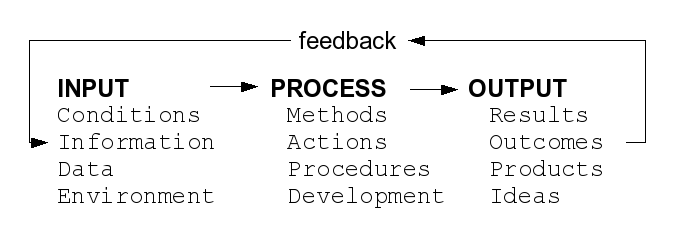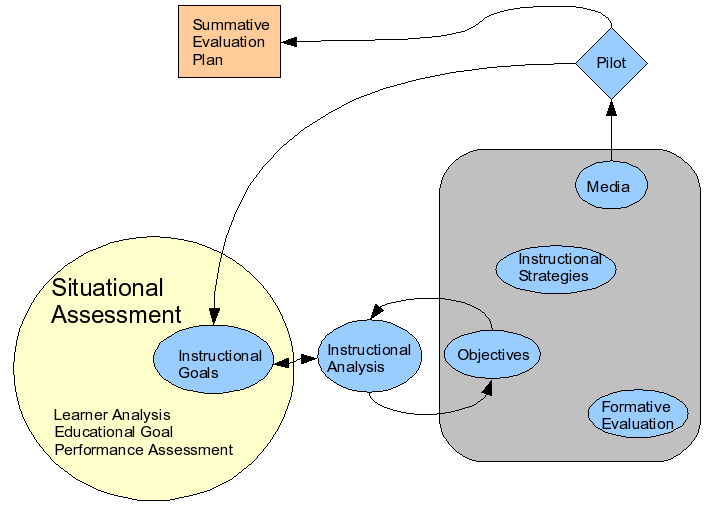Instructional design method
 From EduTechWiki - Reading time: 7 min
From EduTechWiki - Reading time: 7 min
Definition[edit | edit source]
- An instructional design method defines how to organize the whole design process. Frequently such methods are tied to specific instructional design models who in turn are based on learning and teaching theory.
- Frequently, instruction design methods are called instructional design models in the literature. However, we decided to make a distinction, for us an instructional design model represents a class of a pedagogical design, i.e. how to teach, how to bring people to learn, etc.
See also:
- Learning design, Educational design language and educational modelling language (different ways to look at educational design problems)
- Educational software design,
The design process[edit | edit source]
A globally usable/accepted definition does not seem to exist, although most "industrial" instructional design relies on some variant of instructional systems design.
Systems design family[edit | edit source]
According to Edmonds et al. (1994), the systems approach can be characterized by an input-process-output paradigm, as follows:

Such a design process is driven by more or less pre-established goals (e.g. needs), it is systematic and systemic “where the outcomes of each component directly of indirectly impact every other component of the instructional design process to some degree, thus producing a ripple effect” (Edmonds, 1994: 56).
Edmonds et al. (1994:57) defines the following fundamental components of the instructional design process. Similar definitions can be found in instructional systems design models like ADDIE or the Kemp model.

While not necessarily in principle, various instructional designers adopt for economic reasons a more linear industrialized "waterfall model" like the following one:
- Analysis of needs (rough outline of pedagogic goals)
- Identification of knowledge to be acquired (in modular form)
- Identification of constraints (e.g. economical)
- Definition of learning activities and learning materials (in modular form)
- Prototyping and testing
- Deployment and adjustments (as few as possible)
(Willis, 1995) attributes the following eight characteristics to the traditional Objective-Rational Instructional Design method.
- The process is sequential and linear
- Planning is top down and systematic
- Objectives guide development
- Experts, who have special knowledge, are critical to ID work
- Careful sequencing and the teaching of sub-skills are important
- The goal is delivery of preselected knowledge
- Summative evaluation is critical
- Objective data are critical.
We don't agree with the "sequential/linear" attribute since systemic design values (at least in principle) feedback and we don't think that planning is fully top down, although it certainly is supposed to be systematic. The most fundamental principle is that each component of model depends on each other. Therefore, if one changes one component (e.g. ajustment of needs after testing) it will affect ontological analysis and definition of associated learning materials and activities.
Constructivist - Interpretivist[edit | edit source]
According to Lebow (1993) cited by Tam (2000), “Traditional educational technology values of replicability, reliability, communication, and control (Heinich, 1984) contrast sharply with the seven primary constructivist values of collaboration, personal autonomy, generativity, reflectivity, active engagement, personal relevance, and pluralism.”
Willis (1995) cited by Tam (2000) offers an alternative model termed the Constructivist-Interpretivist Instructional Design Model. It has the following characteristics:
- The design process is recursive, non-linear, and sometimes chaotic.
- Planning is organic, developmental, reflective, and collaborative.
- Objectives emerge from design and development work.
- General ID experts do not exist.
- Instruction emphasizes learning in meaningful contexts (the goal is personal understanding within meaningful contexts).
- Formative evaluation is critical.
- Subjective data may be the most valuable.
In the framework of Edmonds (see below), this type of approach would fit into Expert / Soft-System-Based or Expert / Intuitive category. A similar stance against traditional systems design exists among other researchers that stress the emergent nature of the learning process (e.g. Kays and Sims, 2006).
Categories of instructional design methods and design layers[edit | edit source]
Instructional design methods don't all have the same scope. Some just focus on the design process (i.e. they are usually are quite similar to methods found in information systems). Others include topics addressed by instructional design models (how people learn, how instruction works, etc.)
Dimensions of design models[edit | edit source]
Edmonds et al., (1994) distinguish in their framework for comparing instructional design models 6 different dimensions:
- Type of orientation: Prescriptive / Descriptive / (both)
- Descriptive models describe the learning environment and how it affects given variables of interest vs. prescriptive models that outline how to build one an environment in order to affect variables of interest.
- Type of knowledge: Procedural / Declarative / / (both)
- How to reach a goal vs. why to reach a goal.
- Required expertise: Novice / Intermediate / Expert / (suitable for all)
- This is often a distinction between teacher / novice designer or teacher with design experience / instructional designer
- Theoretical origins: Hard Systems / Soft Systems / Intuition / (aspects of each)
- Essentially a distinction between systems theory and alternative theories, e.g. rapid prototyping (soft systems) and approaches like bricolage.
- Institutional context: Primary + secondary (K-12) / Higher education / Business training / Government training / / (some of each)
- (We are not sure if the distinction between business and government training is very relevant)
- Levels: unit / lesson / module / course / curriculum / institutional / mass / (some of each)
- Some models focus only on unit/lesson/module whereas others have a wider scope.
From the first four criteria, Edmonds et al. (1994:65-66) then combine some interesting types of design models:
- Expert / System-Based is characterized by expert instructional designers who have the expertise to use complex system models that operate on a variety of levels. [...]
- Novice / System-Based represents models that are system based and are used by novice instructional designers, for example Dick and Carey's (1990) model. [...]
- Expert / Soft-System-Based is an instructional design model that relies on expert instructional designers to make decisions and to use models which rely on their experience to guide the design. [...]
- Novice / Soft-System-Based is an instructional design model that is meant for novice instructional designers who have knowledge and expertise in a specific context such as teachers. [...]
- Expert / Intuitive-Based is an instructional design model that relies on expert instructional designers to make decisions and to use intuitive models that rely on heuristics, past experience, knowledge and intuition to guide the design. [...]
- Novice / Intuitive-Based is a category in which few, if any, instructional design models are placed. [...]
The 3D model of design documentation[edit | edit source]
Boot (2005:26) argues that “production-related information is typically embedded in three types of building blocks for the production process: (a) design documents as input, (b) programming structures as throughput, and (c) learning materials as output.” Boot et al. 3D model includes three major dimensions:
- stratification: Functionally different instructional and technical structures
- degree of elaboration: conceptual, specification or implementation
- formality: formal vs. informal
See 3D model of design documentation for details.
Design tools[edit | edit source]
There exist a variety of tools.
- Some design methods provide tools, e.g.
- MISA developed the MOT/MOT+ editor that can be used as stand-alone tool.
- lesson planning grids or editors for classroom teaching
- Educational modeling languages (without or without specialized editors)
- Multimedia chain editors like Scenari builder
- Scenarization tools like OASIF (french) and LAMS
- Tools from other design sciences, like UML from computer science
Major instructional design methods[edit | edit source]
Our following classification by "natural genres" is maybe not satisfactory in terms of clearly defined criteria, but also may provide some guidance for further reading. Besides the distinction between "simple" and "complex", it always important to consider whether a method is designed to plan a curriculum as whole (e.g. as in instructional curriculum maps or rather at the lesson level (e.g. as in nine events of instruction) or for both.
Light-weight models[edit | edit source]
Models that are well suited for teachers or designers who prefer to focus on pedagogy
- Backwards design (goal-oriented design)
- various user-centered designs
- rapid prototyping designs
- "Bricolage" models like medium-based design
- Design pattern-based designs
- Most lesson planning methods
"Classic" systemic Design Process models[edit | edit source]
Models that sort of fit what can be called Instructional systems design:
- ADDIE (Analysis, Design, Development, Implement, Evaluate), also called system approach
- Systematic Design of Instruction
- Kemp design model
- Gerlach and Ely design model
- Knirk and Gustafson design model
Large Scope industrial ID[edit | edit source]
In depth pedagogical analysis and scenarization ID[edit | edit source]
- MISA
- IMS Learning Design (not really a design method, but a standard that encourages a learner-activity-driven approach)
Large scope unit planning for educators[edit | edit source]
Links[edit | edit source]
- This needs completion, there are dozens of good web sites
- Multimedia development tools, a very good resource with many models from The Center for Education Integrating Science, Mathematics, and Computing (CEISMC) (pronounced like "seismic"), Georgia Tech.
- Instructional Design Theory by Kenneth J. Smith. Includes both a systems design and a constructivist model.
- Carl Berger's Educational Software Design and Authoring course page. Note: This is a very old page, but it does have some good references.
- Summary of Willis by Song and Brunner.
References[edit | edit source]
Please also check the bibliography of the instructional design article. Here we only list refences cited or ones that specifically related to design (development) method.
- Bagdonis, A. & Salisbury, D. (1994). Development and validation of models in instructional design. Educational Technology, 34 (4), 26-32.
- Boot, Eddy (2005), Building-block solutions for developing instructional software, PhD Dissertation, Open Universiteit Nederland. PDF and PDF
- Botturi, L., Derntl, M., Boot, E., & Figl, K. (2006). A Classification Framework for Educational Modeling Languages in Instructional Design. Proceedings of The 6th IEEE International Conference on Advanced Learning Technologies, 1216-1220 PDF.
- Edmonds Gerald S, Robert C, Branch and Prachee Mukherjee (1994), A Conceptual Framework for Comparing Instructional Design Models, ETR&D, VoL 42, No. 4, 1994, pp. 55-72 LSSN 1042-1629. PDF (Access restricted)
- Gibbons Andrew S. (2000), What and How Designers Design: A Theory of Design Structure, paper presented at the november 2000 meeting of the Association for Educational Communications and Technology. Word
- Gibbons Andrew S., Luca Botturi, Eddy Boot, Jon Nelson (2007 ?) Design languages, chapter 45, in Ch. Reigeluth (ed.) (forthcoming). Instructional-Design Theories and Models: Vol 3.
- Gustafson Kent and Robert Maribe Branch (1997). Revisioning models of instructional development, Educational Technology Research and Development, 45, 3, 9/18/1997, Pages 73-89, DOI 10.1007/BF02299731 (Access restricted)
- Gustafson Kent and Robert Maribe Branch (2002), Survey of Instructional Development Models, 4th edition, Eric Clearinghouse on Information, ISBN 0937597554 (Probably the best short overview book you can find, recommended by DSchneider. PS: It is not clear to me whether there is a long and a short version. Mine has 71 pages and it was cheap)
- Irlbeck, S., Kays, E., Jones, D. & Sims, R. (2006). The phoenix rising: Emergent models of instructional. design. Distance Education, 27(2), August 2006.
- Kays, E. and Sims, R. Reinventing and reinvigorating instructional design: A theory for emergent learning, Ascilite 2006. PDF.
- Lebow, D. (1993). Constructivist values for systems design: five principles toward a new mindset. Educational Technology Research and Development, 41, 4-16.
- Mager, R. F. (1984). Preparing instructional objectives (2nd ed.). Belmont, CA: Pitman.
- Tam, Maureen (2000), Constructivism, Instructional Design, and Technology: Implications for Transforming Distance Learning, Educational Technology & Society 3(2) 2000, ISSN 1436-4522, HTML PDF
- Willis, J. (1995). Recursive, reflective instructional design model based on constructivist-interpretist theory. Educational Technology, 35 (6), 5-23.
 KSF
KSF